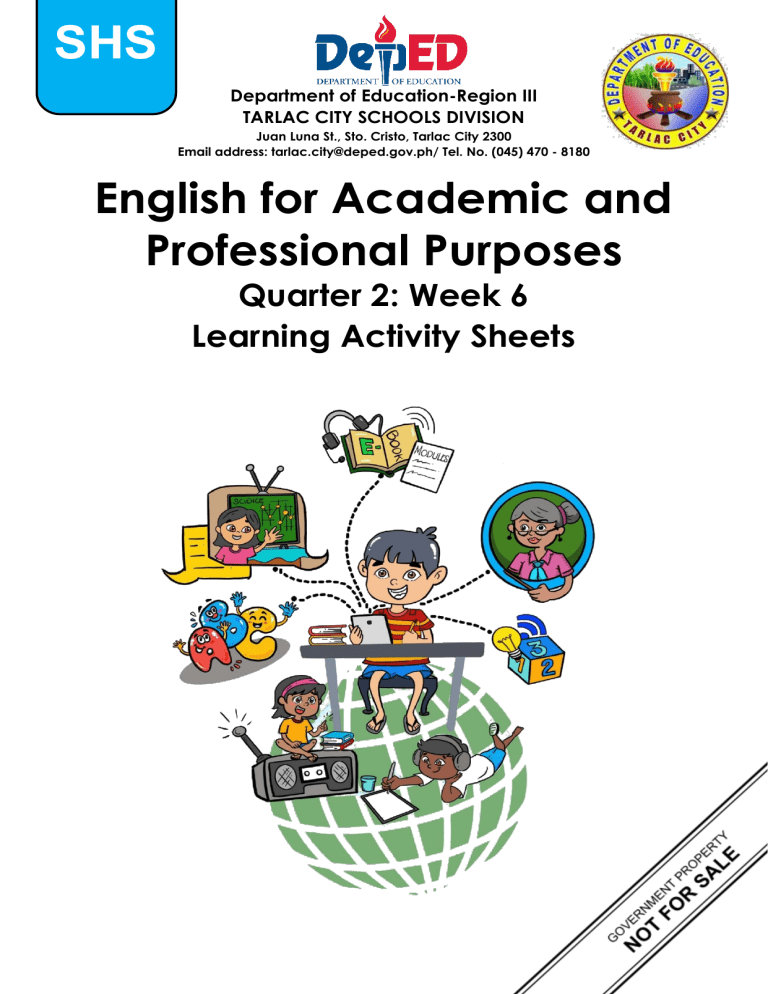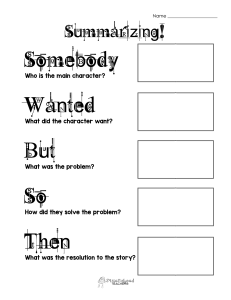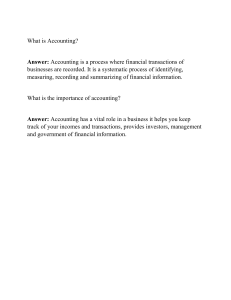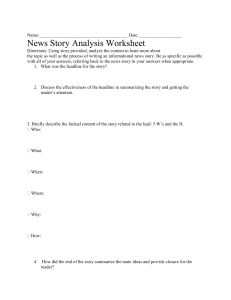English for Academic Purposes Learning Activity Sheets
advertisement

SHS Department of Education-Region III TARLAC CITY SCHOOLS DIVISION Juan Luna St., Sto. Cristo, Tarlac City 2300 Email address: tarlac.city@deped.gov.ph/ Tel. No. (045) 470 - 8180 English for Academic and Professional Purposes Quarter 2: Week 6 Learning Activity Sheets ENGLISH FOR ACADEMIC AND PROFESSIONAL PURPOSES Name of Learner: _________________________ Section: ________________________________ Grade 11/12 Q2/Q4 - WEEK 6 Date: _________________________ Summarizing Findings and Executing the Report through Narrative and Visual/Graphic Forms Background Information You have conducted a research and your respondents already completed the survey you provided for them. Also, you are done interviewing some knowledgeable people who are needed to solve your research problems. Now, what do you do with your findings? The findings of research must be properly documented according to the analysis of the audience. The research report must be according to the interest of the targeted audience to serve them better. Every finding must be documented within the given time frame for the audience. The methodology of finding will change according to the need of the audience. (Source: Tariq, Muhammad Usman & Butt, Saad. 2016.) The findings of your study should be presented and summarized on your paper. This part of your manuscript is commonly called, “Summary of Findings”. A component of summary of the findings is to provide a discussion for each of the findings, using anchor verbiage that justifies rather than distorts the intent of the findings. In the summary, the writer should tell how the findings are important or relevant based on the aim and scope of the study. In addition, another component of the summary of the findings is to compare or link the findings to the studies outlined in the literature review of the study. Are they the same, different or new? (Source: USC Rossier School of Education) Summarizing Findings of a Report through Narrative Forms Whether you’re running the numbers for a client or presenting the results of your latest research, crafting a strong, compelling report is crucial to keep your reader’s attention, make the information easier to comprehend, and influence their decision-making. Unfortunately, we see too many reports that are too dense or dull to capture a reader’s attention. Even if you have fascinating insights or compelling data, a weak visualization, sloppy report design, or incohesive narrative can make your reader tune out pretty quickly. Like any piece of content, a report can benefit from the same storytelling treatment that you give any piece of content marketing. With a strong narrative and slick report design, you can turn your numbers into an interesting and exciting piece of content that truly connects with your reader. (Source: French, Katie. n.d. “7 Report Design and Storytelling Tips to Capture (and Keep) Your Readers’ Attention”. Accessed October 8, 2020, https://www.columnfivemedia.com/7-report-design-and-storytelling-tips) How do you summarize? When you summarize, you explain the main idea(s) from someone else’s work. Note that you must include citation information for summaries – think of your citation as showing your reader where they can find the original or “full” version of the work that you have summarized. In They Say/I Say, Gerald Graff and Cathy Birkenstein describe summarizing as “putting yourself in the shoes of someone else” (2014, p. 31). They use this description because effective summarizing requires that you engage with and aim to understand someone else’s ideas or 1 perspective, even if you disagree. It can be helpful to think of a summary as a brief description of someone else’s work that they, themselves, would recognize and consider to be a fair representation. Try these steps for writing summaries: 1. Select a short passage (about one to four sentences) that supports an idea in your paper. 2. Read the passage carefully to fully understand it. 3. Take notes about the main idea and supporting points you think you should include in your summary. Include keywords and terms used by the author and think, too, about how the source ideas are relevant to the argument(s) that you are presenting in your paper. 4. Using only your notes, explain the original author’s main ideas to someone else. Then explain how those ideas support or conflict with your own argument. 5. Reread the original source. Is there important information that you have forgotten or misremembered? Is your summary very similar to the original source? 6. Add in-text citation and check the required formatting style. (Source: Lane, Julie. 2020. “Summarizing: How to effectively summarize the work of others”. Accessed October 8, 2020, https://www.lib.sfu.ca/about/branches-depts/slc/writing/sources/summarizing.) Executing Reports using Visual/Graphic Forms Most technical communications require more than text to concisely and accurately communicate concepts or techniques. Tables, graphs, sketches, equations, and photographs can also be added to present data as clearly as possible. The text should tell the story and figures, tables, and equations can be used to support or organize the text. Most assignments will only require simple data visualization such as graphing a set of points, but it is important to establish good habits when creating graphics. Graphics can make large amounts of data accessible to your reader. However, graphics have to be created properly to aid understanding. Crowded or busy graphics can leave readers more confused than they were before. Graphs drawn incorrectly can cause readers to draw inaccurate conclusions. Data can be used to mislead readers when not represented responsibly. Visuals should be chosen based on their ability to communicate the intended message. Lab directions will often suggest what type of visualization to create, but you should know which to select if it is not dictated. Take a look at Figure 1. Visual Type Table Scatter plot Bar graph Line graph When to Use A table is useful when many specific values need to be accessible (e.g., comparing trial runs, displaying measured speeds or mass). Scatter plots are ideal when plotting many points where both the independent and dependent variables are numerical. Once the data is plotted, trend lines might be identified and drawn in Excel or other data software to suggest an approximate relationship between the two variables. Bar graphs are typically useful in cases when the independent variable is a category (or rank) and the dependent variable is numerical (e.g., showing number units sold in the last 4 quarters, enrollment numbers for classes). Line graphs are often used in situations where there is a mathematical relationship between X and Y, such as graphing equations. In other contexts, they might be used to visualize trends (past and/or predictive) and other dependent relationships. 2 Pie charts can be useful when you are trying to group items or populations by percent, into five or fewer categories (e.g., categorize a city’s age demographics). Percent values should be labeled. Formulas are needed whenever a calculation is part of the analysis, unless it Equation is a calculation where there is a universal understanding of the associated equation, such as the average of a set of numbers. Sample Sample calculations are used to provide the reader with step by-step calculation examples of values obtained from data analysis. Figure 1. Types of Visual Representation of Findings Pie chart Remember: Choose the visual that will most effectively convey the information to the reader. Introduce and explain each visual as it appears in the text. Visuals without descriptions are rarely helpful for an unfamiliar audience. Use good practices to make graphs clear and easy to read. Maintain consistent style and formatting throughout your visuals to avoid distracting from the message. (Source: Wahlin, Leah. n.d.) Visual/Graphic Forms and their Examples 1. Tables arrange information in a row and column format. Each table should have a label above the table that contains a number and a title. Labels should be centered and follow the format “Table 1. A brief descriptive title in sentence case.” Tables do not need to follow specific color or formatting standards, but they should be easy to read and uniform throughout the document (Source: Wahlin, Leah. n.d.). Example 1 Age Range 16-19 20-23 24-26 27 and above Total Table 1. Age of the respondents Frequency 32 57 21 8 118 Percentage 27% 48% 18% 7% 100% Example 2 Table 2. Weighted mean effect sizes for ESL studies by geographical location and region 3 (Source: Adesope, et al. 2011) 2. Figures For the purpose of documentation, anything that is not text, equation, or a table is a figure. Graphs, sketches, and photos are all figures. Figure labeling and referencing is almost identical to that of tables, except that figures are labeled below the figure. Labels should be centered and follow the format “Figure 1. A brief descriptive title in sentence case.” (Source: Wahlin, Leah. n.d.) Examples: Figure 2. SHS strands HUMSS STEM ABM 8% 24% 20% 16% 22% 10% Figure 3. Digital competence level 3. Equations should be centered, with a single space before and after a set of equations. If equations are grouped, the spacing can be 1.5. If the equation has a specific name, it can be listed on the left. Example 1 Ohm’s Law V=IRV=IR (Volts) = (Amps) * (Ohms) (1) Ohm’s Law V=IRV=IR (V) = (A) * (Ω) (2) Example 2 (Source: Wahlin, Leah. n.d.) Learning Competency with Code Summarizes findings and executes the report through narrative and visual/graphic forms (CS_EN11/12A-EAPPIIe-j-11) Directions/ Instructions Read and follow the specific directions of each succeeding activity. 4 Exercises and Activities A. Complete the given data in Table 3 and provide what is asked thereafter. Table 3. Preferred learning delivery modalities (LDM) of HUMSS students Section Modular Online Blended Total A 27 0 13 40 B 34 0 5 39 C 12 4 25 41 D 20 7 16 43 Total A.1 Answer the following guide questions: 1. How many students does HUMSS strand have? _______ 2. Which section contains the highest number of students who chose modular? _______ 3. Which section contains the lowest number of students who chose modular? _______ 4. Which LDM has the highest number? _______ 5. Which LDM has the lowest number? _______ A.2 Now, present the table above by composing a paragraph. Use the guide questions and your answers above. As shown in Table 3, _______________________________________________________________________________ _______________________________________________________________________________ _______________________________________________________________________________ _______________________________________________________________________________ _______________________________________________________________________________ B. Use the data provided in Table 3 to present the percentages of the three learning delivery modalities. B.1 Fill-in the table below. Table 4. Learning Delivery Modalities LDM Frequency Percentage Modular Online Blended Total B.2 Now, present the table above by composing a paragraph about the data in it. 5 Table 3 shows that _______________________________________________________________________________ _______________________________________________________________________________ _______________________________________________________________________________ _______________________________________________________________________________ _______________________________________________________________________________ C. Conduct an online survey (through Facebook) about a topic of your interest (e.g. movie genres, most favorite ice cream flavor, mostly used emojis, etc.). Provide 2 or more options for the respondents. Then, create a PIE CHART and interpret the results in the table below. Note: Write the TITLE OF YOUR FINDINGS. ________________________ _________________________________________________________________________________________ _________________________________________________________________________________________ _________________________________________________________________________________________ _________________________________________________________________________________________ _________________________________________________________________________________________ _________________________________________________________________________________________ D. Collaborate with a partner virtually and interview each other about a certain important topic you want to talk about right now (e.g. Learning Activity Sheets, online classes, health issues, Covid-19 cases, etc.). One of you should be the interviewer and the other is the interviewee. Voice-record your interview, then transcribe (this means you must write down exactly the recording of your interview). Use an extra sheet of paper for your transcription and attach it with this LAS. After transcribing, summarize your interview using graphic and narrative/textual forms. Use the space provided below. 6 References Adesope, et al. 2011. “Pedagogical strategies for teaching literacy to ESL immigrant students: A meta-analysis”. The British journal of educational psychology. Accessed October 8, 2020, https://www.researchgate.net/publication/51767663_Pedagogical_strategies_for_teac hing_literacy_to_ESL_immigrant_students_A_meta-analysis. Lane, Julie. 2020. “Summarizing: How to effectively summarize the work of others”. Accessed October 8, 2020, https://www.lib.sfu.ca/about/branchesdepts/slc/writing/sources/summarizing.) Tariq, Muhammad Usman & Butt, Saad. 2016. “Basics of Summarizing Research Findings”. Durresamin Journal. Accessed October 8, 2020, https://www.researchgate.net/publication/311671208_Basics_of_Summarizing_Resea rch_Findings USC Rossier School of Education. “Navigating the dissertation”. Accessed October 7, 2020, http://dissertationedd.usc.edu/draft-the-summary-of-findings.html. Wahlin, Leah. n.d. “Chapter 4. Using graphics and visuals effectively”. Fundamentals of Engineering Technical Communications. Accessed October 8, 2020, https://ohiostate.pressbooks.pub/feptechcomm/chapter/4-graphics-visuals/. Answer Key A.1 A.2 1. 2. 3. 4. 5. Answers may vary. 163 SECTION B / HUMSS-B SECTION C / HUMSS-C MODULAR ONLINE B.1 B.2 Answers may vary. LDM Frequency Percentage Modular 93 57% Online 11 7% Blended 59 36% Total 163 100% C. Findings may vary. D. Findings may vary. Prepared by: LORDELYN Y. PULMANO Teacher II Evaluator: Editor: REYMAR D. PAGUIO, PhD Master Teacher I JOHN-JOHN J. FLORES, PhD SHS Focal Person/Head Teacher 7






